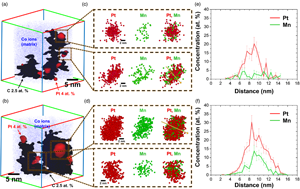Article contents
Tracking the Mn Diffusion in the Carbon-Supported Nanoparticles Through the Collaborative Analysis of Atom Probe and Evaporation Simulation
Published online by Cambridge University Press: 17 October 2022
Abstract

Carbon-supported nanoparticles have been used widely as efficient catalysts due to their enhanced surface-to-volume ratio. To investigate their structure–property relationships, acquiring 3D elemental distribution is required. Here, carbon-supported Pt, PtMn alloy, and ordered Pt3Mn nanoparticles are synthesized and analyzed with atom probe tomography as model systems. A significant difference of Mn distribution after the heat-treatment was found. Finally, the field evaporation behavior of the carbon support was discussed and each acquired reconstruction was compared with computational results from an evaporation simulation. This paper provides a guideline for studies using atom probe tomography on the heterogeneous carbon-supported nanoparticle system that leads to insights toward a wide variety of applications.
Keywords
- Type
- Materials Science Applications
- Information
- Copyright
- Copyright © The Author(s), 2022. Published by Cambridge University Press on behalf of the Microscopy Society of America
Footnotes
These authors contributed equally to this work.
References
- 4
- Cited by





